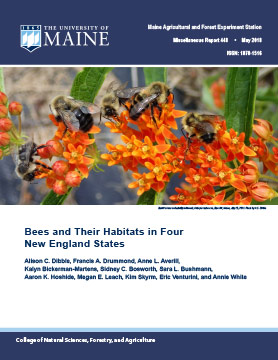Bees and Their Habitats in Four New England States

Description: Four states contain over 400 species of bees, about which little is known except for a few common species. Forests of Maine, Massachusetts, New Hampshire, and Vermont were largely cleared in colonial times, then trees grew back as of the 1870s. Canopy closure, urbanization, and intensive agriculture have led to reduced habitats for bees. Managed and wild bees of the region are found especially in forest openings. Many visit flowers across different plant species, though an estimated 15% visit only one or a few plant taxa. Because bee life histories, population dynamics, and host plant relations are incompletely known, an emphasis on habitat is appropriate because the environment can be manipulated. We list 15 bee habitats with natural and anthropogenic features, and suggest 40 plant taxa that may be effective in plantings for bees. Pollination systems in two native crops, lowbush blueberry (Vaccinium angustifolium) and cranberry (V. macrocarpon), are better-studied than most crops; from these we developed an economic perspective on altering habitat to support bees. Threats to bees include habitat loss, pests and pathogens, pesticides, and climate change. We consider practical aspects for improving pollinator habitats. The adoption of suggested habitat improvements will help meet goals in bee conservation and pollination security, and could aid in protecting pollination of the native flora. We identify gaps in knowledge to help prioritize future research directions.
Publisher: Maine Agricultural and Forest Experiment Station
Publication date: May 2018
Download link: Bees and Their Habitats in Four New England States
Printed guides: We have a limited quantity of printed guides available. If you have a need for a printed copy, please send a request to northeastipm@cornell.edu.
